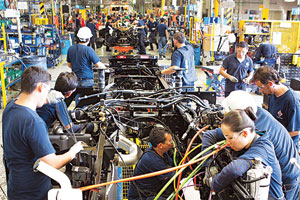Managing Editor, Features and Multimedia
June Truck Orders Fall 26%

New Class 8 truck orders declined in June and dipped below the 20,000 mark for the first time since 2013, ACT Research reported.
But industry backlogs remain well above prior-year levels despite orders dropping for the fourth consecutive month.
North American truck makers booked a total of 19,900 net orders last month, down 26% from 26,729 units a year earlier and a 3% decline from 20,533 in May, according to ACT’s preliminary data.
ACT President Kenny Vieth described the ongoing downturn in orders as “a reflection of meaningfully larger backlogs rather than any structural change in demand.”
Order activity has slowed largely because manufacturing capacity for 2015 is nearly full, Vieth said. At the end of June, the industry was probably down to about 30,000 open build slots for the remainder of the year, he said.
The last time Class 8 truck orders were fewer than 20,000 was in September 2013, when they stood at 18,895 units.
This year’s production capacity began to fill up rapidly in the fourth quarter of 2014, when incoming orders averaged 43,600 units per month. At that time, many fleets placed orders earlier than usual to lock in favorable timing to take delivery of new equipment, especially for certain truck-powertrain combinations that were selling quickly.
“Everybody knew the market was hot, and they wanted to make sure they got the build slots they wanted,” Vieth said.
Meanwhile, research firm FTR reported that preliminary Class 8 orders were 19,624 units in June, down 25% from a year ago and a 2% decline from May.
“The drop in orders is not cause for concern at all,” said FTR Vice President Don Ake. “Fleets right now are evaluating their 2016 requirements, and quoting activity by the OEMs has just started. Class 8 orders will remain rather subdued until the fall order season kicks in this October.”
Matt McConnell, CEO at Black Rock Truck Group, a Freightliner dealer based in Branford, Connecticut, said order activity at his business is about even with a year ago, but he agreed that the scarcity of available build slots has contributed to the industrywide slowdown in orders.
Many of Black Rock’s customers are still asking for new trucks as soon as they can get their hands on them, but other fleets with very specific buying cycles have already begun discussing their 2016 equipment needs, he said.
“We’re already having those discussions, and typically we don’t have them until later in the year,” McConnell said. “Their fear is a build-out. We’re already in the planning process with them.”
Industry analysts agreed June’s lower order tally was in line with expectations.
“Despite the weaker orders, investors should continue to have confidence that production will remain elevated in 2015,” said Ann Duignan of J.P. Morgan Securities.
Rhem Wood of BB&T Capital Markets said the latest order total was “underwhelming” but not necessarily a surprise. He, too, attributed the decline to high industry backlogs and limited remaining build slots this year.
Markus Pfeifer, director of marketing operations and planning at Daimler Trucks North America, said the company’s Class 8 order share in June stood at 41.3% of the market.
“We are still seeing a strong desire from fleets to replace old vehicles with new, more driver-friendly and fuel-efficient vehicles that will add to their bottom line,” he said.
Other manufacturers did not comment by press time.
Final figures for June backlogs weren’t yet available, but the industry had 168,700 Class 8 trucks on order at the end of May, compared with 118,600 a year earlier, ACT said. The backlog likely declined by about 10,000 units in June as production outpaced the rate of order intake, Vieth said.
In the first half of the year, Class 8 orders totaled 154,700 units, down 8% from 169,000 in the first six months of 2014, ACT said.
Although most 2015 build slots are already taken, Vieth said it’s still too early for many fleets to place large orders for next year’s models.
As a result, order activity will likely be soft in the next couple months — perhaps in the 15,000-unit range — before ramping up again in September, he said.
“There’s not a lot of [manufacturing] capacity, and it’s really too soon to get a lot of activity into next calendar year, so we expect pretty weak results,” Vieth said.
The industry could see another strong fourth quarter, though.
“It certainly wouldn’t surprise me if orders again hit 40,000 in October this year,” Vieth said.
Looking ahead to next year, he predicted that freight capacity will loosen to some extent due to strong Class 8 retail sales in 2015 and productivity gains from Congress’ rollback of a key restart provision in the hours-of-service rule.
“There’s not going to be the same degree of tightness in the market in the beginning of 2016 as there was at the beginning of 2015,” he said.




